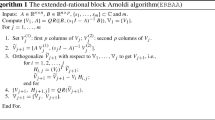Abstract
In this paper, we consider the balanced truncation method for model reductions in large-scale linear and time-independent dynamical systems with multi-inputs and multi-outputs. The method is based on the solutions of two large coupled Lyapunov matrix equations when the system is stable or on the computation of stabilizing positive and semi-definite solutions of some continuous-time algebraic Riccati equations when the dynamical system is not stable. Using the rational block Arnoldi, we show how to compute approximate solutions to these large Lyapunov or algebraic Riccati equations. The obtained approximate solutions are given in a factored form and used to build the reduced order model. We give some theoretical results and present numerical examples with some benchmark models.


Similar content being viewed by others
Notes
Oberwolfach model reduction benchmark collection, 2003. http://www.imtek.de/simulation/benchmark.
References
Abidi O, Hached M, Jbilou K (2016) Adaptive rational block Arnoldi methods for model reductions in large-scale MIMO dynamical systems. N Tren Math 4(2):227–239
Abou-Kandil H, Freiling G, Ionescu V, Jank G (2003) Matrix Riccati equations in control and sytems theory. In: Sys. & Contr. Foun. & Appl. Birkhauser, Boston
Antoulas AC (2005) Approximation of large-scale dynamical systems. Adv. des. contr. SIAM, Philadelphia
Bartels RH, Stewart GW (1972) Solution of the matrix equation \( AX+XB=C \). Commun ACM 15:820–826
Benner P, Li J, Penzl T (2008) Numerical solution of large Lyapunov equations, Riccati equations, and linear-quadratic optimal control problems. Numer Lin Alg Appl 15(9):755–777
Bittanti S, Laub A, Willems JC (1991) The Riccati equation. Springer, Berlin
Datta BN (2003) Numerical methods for linear control systems design and analysis. Elsevier Academic Press, Amsterdam
Druskin V, Simoncini V (2011) Adaptive rational Krylov subspaces for large-scale dynamical systems. Syst Contr Lett 60:546–560
El Guennouni A, Jbilou K, Riquet AJ (2002) Block Krylov subspace methods for solving large Sylvester equations. Numer Alg 29:75–96
Fortuna L, Nunnari G, Gallo A (1992) Model order reduction techniques with applications in electrical engineering. Springer, London
Glover K (1984) All optimal Hankel-norm approximations of linear multivariable systems and their L-infinity error bounds. Inter J Cont 39:1115–1193
Gugercin S, Antoulas AC (2004) A survey of model reduction by balanced truncation and some new results. Inter J Cont 77(8):748–766
Heyouni M, Jbilou K (2009) An extended block Arnoldi algorithm for large-scale solutions of the continuous-time algebraic Riccati equation. Elect Trans Num Anal 33:53–62
Jaimoukha IM, Kasenally EM (1994) Krylov subspace methods for solving large Lyapunov equations. SIAM J Matrix Anal Appl 31(1):227–251
Jbilou K (2010) ADI preconditioned Krylov methods for large Lyapunov matrix equations. Lin Alg Appl 432(10):2473–2485
Jbilou K (2006) Low rank approximate solutions to large Sylvester matrix equations Appl. Math Comput 177:365–376
Jbilou K (2003) Block Krylov subspace methods for large continuous-time algebraic Riccati equations. Numer Alg 34:339–353
Jbilou K (2006) An Arnoldi based method for large algebraic Riccati equations. Appl Math Lett 19:437–444
Kleinman BN (1968) On an iterative technique for Riccati equation computations. IEEC Trans Autom Contr 13:114–115
Laub AJ (1979) A Schur method for solving algebraic Riccati equations. IEEE Trans Automat control 24:913–921
Mehrmann V, Penzl T (1998) Benchmark collections in SLICOT. Technical report SLWN1998- 5, SLICOT working note, ESAT, KU Leuven, K. Mercierlaan 94, Leuven-Heverlee 3100, Belgium, 1998. http://www.win.tue.nl/niconet/NIC2/reports.html
Moore BC (1981) Principal component analysis in linear systems: controllability, observability and model reduction. IEEE Trans. Autom. Contr. 26:17–32
Mullis CT, Roberts RA, Trans IEEE Acoust Speec Signal Process 24 (1976)
Penzl T (2012) LYAPACK A MATLAB toolbox for large Lyapunov and Riccati equations. In: Model reduction problems, and linear-quadratic optimal control problems. http://www.tu-chemintz.de/sfb393/lyapack
Simoncini V (2007) A new iterative method for solving large-scale Lyapunov matrix equations. SIAM J Sci Comput 29(3):1268–1288
Author information
Authors and Affiliations
Corresponding author
Rights and permissions
About this article
Cite this article
Abidi, O., Jbilou, K. Balanced truncation-rational Krylov methods for model reduction in large scale dynamical systems. Comp. Appl. Math. 37, 525–540 (2018). https://doi.org/10.1007/s40314-016-0359-z
Received:
Revised:
Accepted:
Published:
Issue Date:
DOI: https://doi.org/10.1007/s40314-016-0359-z



